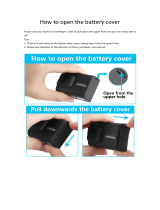1. It is the responsibility of the owner to ensure
that all users of this treadmill are adequately
informed of all warnings and precautions.
2. Use the treadmill only as described in this
manual.
3. Place the treadmill on a level surface, with at
least eight feet of clearance behind it and two
feet on each side. Do not place the treadmill
on any surface that blocks air openings. To
protect the floor or carpet from damage, place
a mat under the treadmill.
4. Keep the treadmill indoors, away from mois-
ture and dust. Do not put the treadmill in a
garage or covered patio, or near water.
5. Do not operate the treadmill where aerosol
products are used or where oxygen is being
administered.
6. Inspect and properly tighten all parts of the
treadmill regularly.
7. Keep children under the age of 12 and pets
away from the treadmill at all times.
8. The treadmill should not be used by persons
weighing more than 250 pounds.
9. Never allow more than one person on the
treadmill at a time.
10. Wear appropriate exercise clothes when using
the treadmill. Do not wear loose clothes that
could become caught in the treadmill. Athletic
support clothes are recommended for both
men and women. Always wear athletic shoes.
Never use the treadmill with bare feet, wearing
only stockings, or in sandals.
11. When connecting the power cord (see page
10), plug the power cord into a surge sup-
pressor (not included) and plug the surge
suppressor into a grounded circuit capable of
carrying 15 or more amps. No other appliance
should be on the same circuit. Do not use an
extension cord.
12. Use only a single-outlet surge suppressor that
meets all of the specifications described on
page 10. To purchase a surge suppressor, see
your local WESLO dealer or call 1-800-806-
3651 and order part number 146148.
13. Failure to use a properly functioning surge
suppressor could result in damage to the con-
trol system of the treadmill. If the control sys-
tem is damaged, the walking belt may change
speed or stop unexpectedly, which may result
in a fall and serious injury.
14. Keep the power cord and the surge suppres-
sor away from heated surfaces.
15. Never move the walking belt while the power
is turned off. Do not operate the treadmill if
the power cord or plug is damaged, or if the
treadmill is not working properly. (See page 5
if the treadmill is not working properly.)
16. Never start the treadmill while you are stand-
ing on the walking belt. Always hold the
handrails while using the treadmill.
17. The treadmill is capable of high speeds.
Adjust the speed in small increments to avoid
sudden jumps in speed.
18. Never leave the treadmill unattended while it is
running. Always remove the key and unplug
the power cord when the treadmill is not in use.
19. Do not attempt to raise, lower, or move the
treadmill until it is properly assembled. (See
ASSEMBLY on page 6, and HOW TO MOVE
THE TREADMILL on page 13.) You must be
able to safely lift 45 pounds (20 kg) to raise,
lower, or move the treadmill.
20. Do not change the incline of the treadmill by
placing objects under the treadmill.
21. Use the hand weights only at walking speeds.
Using weights and not holding the handrails
may compromise your ability to maintain your
balance. Exercises using weights should be
attempted only by experienced users.
WARNING:To reduce the risk of burns, fire, electric shock, or injury to persons, read the
following important precautions and information before operating the treadmill.
IMPORTANT PRECAUTIONS
3





















